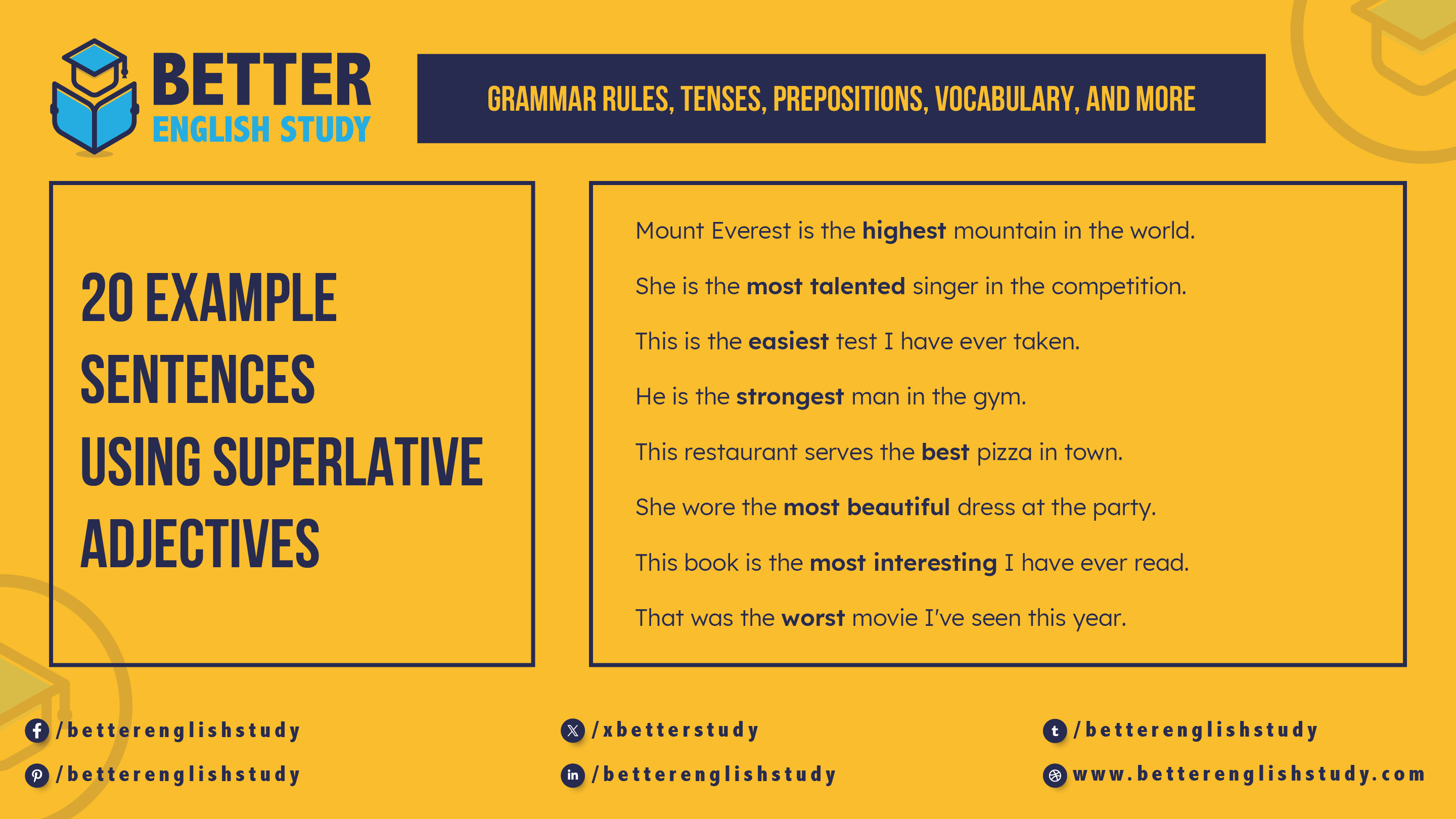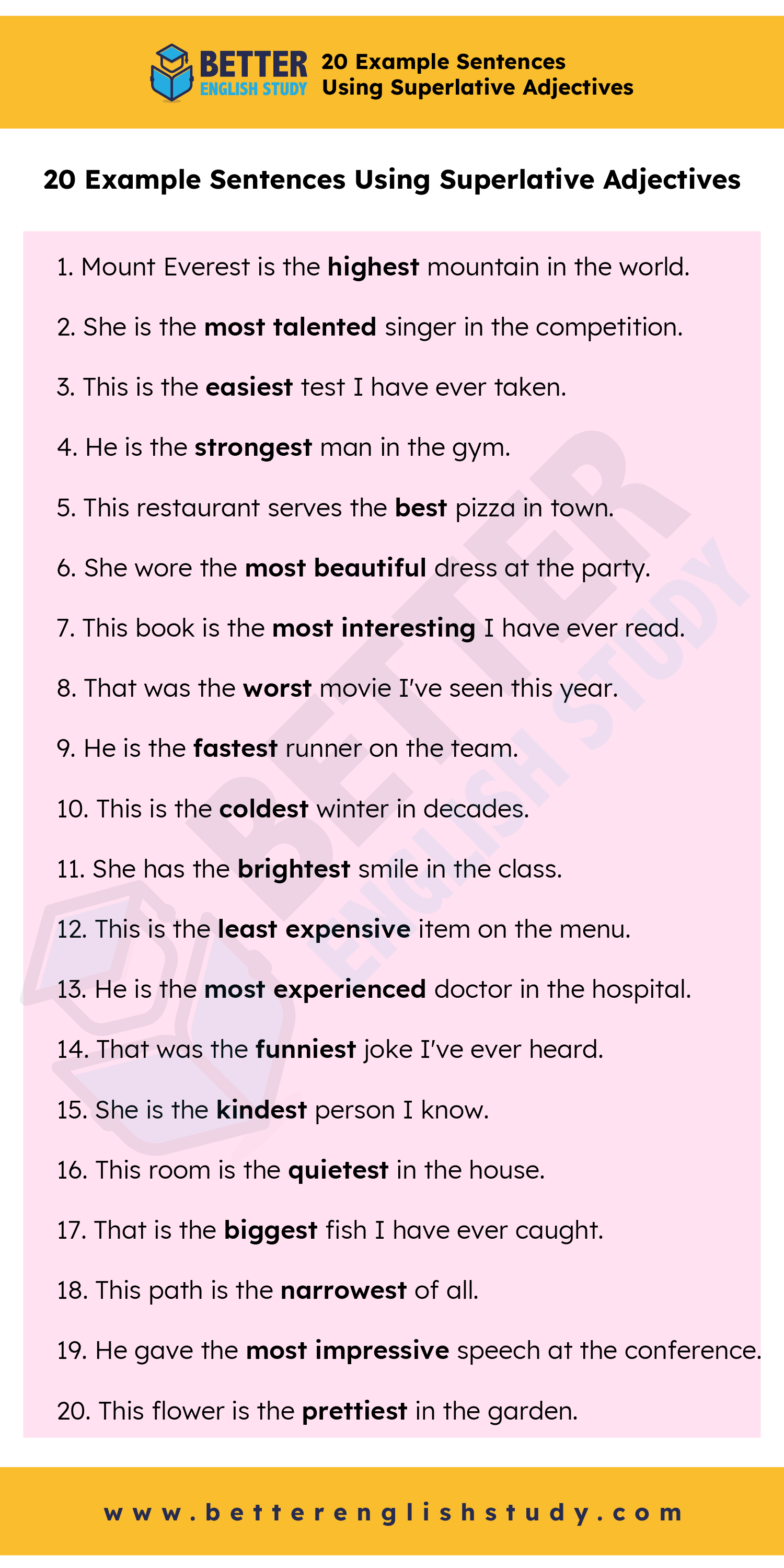
Have you ever wanted to describe someone or something as the best, the worst, the tallest, or the smallest? Superlative adjectives are the words we use to express the highest or lowest degree of quality among three or more items. They help us identify extremes and make our descriptions vivid and precise.
What Are Superlative Adjectives?
Superlative adjectives are used to show the highest degree of quality in one thing compared to multiple others. They indicate that something has the most or least of a particular quality.
For example:
- Mount Everest is the tallest mountain in the world.
- She is the most talented singer in the competition.
These adjectives usually end in “-est” or are preceded by “most” or “least.”
Definition of Superlative Adjectives
According to the Merriam-Webster Dictionary, a superlative adjective is “of, relating to, or constituting the degree of grammatical comparison that denotes an extreme or unsurpassed level or extent”.
How to Use Superlative Adjectives in a Sentence
Using superlative adjectives correctly involves understanding the structure of the sentence and the specific form of the adjective. Here is a formula that can help you construct sentences with superlative adjectives:
Subject + Verb + the + Superlative Adjective + (Noun) + in/of + Group
Examples:
1. John is the strongest athlete on the team.
- Subject: John
- Verb: is
- Superlative Adjective: the strongest
- Noun: athlete (optional)
- Group: in the team
- Explanation: The superlative adjective “the strongest” indicates that John has the highest degree of strength among all athletes on the team.
2. This puzzle is the easiest of all the puzzles.
- Subject: This puzzle
- Verb: is
- Superlative Adjective: the easiest
- Group: of all the puzzles
- Explanation: “The easiest” shows that this puzzle has the highest degree of ease among all the puzzles being compared.
3. She is the most intelligent student in her class.
- Subject: She
- Verb: is
- Superlative Adjective: the most intelligent
- Noun: student (optional)
- Group: in her class
- Explanation: “The most intelligent” denotes that she has the highest degree of intelligence among all the students in her class.
In each example, the superlative adjective modifies the noun (either explicitly or implicitly) and provides a clear indication of the highest or lowest degree of quality.

Rules for Forming Superlative Adjectives
Forming superlative adjectives follows specific rules, depending on the adjective’s length and ending. Here are the main rules:
1. One-Syllable Adjectives
For most one-syllable adjectives, add “-est.”
- Tall → Tallest
- Fast → Fastest
2. Adjectives Ending in -e
For adjectives ending in “-e,” add “-st.”
- Large → Largest
- Nice → Nicest
3. Adjectives Ending in a Consonant-Vowel-Consonant
For adjectives ending in a consonant-vowel-consonant pattern, double the final consonant and add “-est.”
- Big → Biggest
- Hot → Hottest
4. Two-syllable adjectives Ending in -y
For two-syllable adjectives ending in “-y,” change the “y” to “i” and add “-est.”
- Happy → Happiest
- Busy → Busiest
5. Adjectives with Two or More Syllables
For adjectives with two or more syllables, use “most” or “least” before the adjective.
- Beautiful → Most Beautiful
- Interesting → Most interesting
Superlative Adjectives Table
| Regular Adjective | Superlative Adjective |
| Small | Smallest |
| Large | Largest |
| Fast | Fastest |
| High | Highest |
| Easy | Easiest |
| Busy | Busiest |
| Happy | Happiest |
| Strong | Strongest |
| Intelligent | Most intelligent |
| Beautiful | Most beautiful |
20 Example Sentences Using Superlative Adjectives
- Mount Everest is the highest mountain in the world.
- She is the most talented singer in the competition.
- This is the easiest test I have ever taken.
- He is the strongest man in the gym.
- This restaurant serves the best pizza in town.
- She wore the most beautiful dress at the party.
- This book is the most interesting I have ever read.
- That was the worst movie I’ve seen this year.
- He is the fastest runner on the team.
- This is the coldest winter in decades.
- She has the brightest smile in the class.
- This is the least expensive item on the menu.
- He is the most experienced doctor in the hospital.
- That was the funniest joke I’ve ever heard.
- She is the kindest person I know.
- This room is the quietest in the house.
- That is the biggest fish I have ever caught.
- This path is the narrowest of all.
- He gave the most impressive speech at the conference.
- This flower is the prettiest in the garden.
Differences Between Comparative and Superlative Adjectives
The main difference between comparative and superlative adjectives is that comparative adjectives are used to compare two items, indicating more or less of a particular quality, while superlative adjectives are used to show the highest or lowest degree of quality among three or more items.
Let’s know more about these two adjectives to make it more clear.
1. Purpose
- Comparative Adjectives: Used to compare two items.
- Example: “This book is more interesting than that one.”
- Superlative Adjectives: Used to indicate the extreme quality of one item in a group of three or more.
- Example: “This is the most interesting book I have ever read.”
2. Form
- Comparative Adjectives:
- For one-syllable adjectives, add “-er” (e.g., taller, faster).
- For two-syllable adjectives ending in “-y,” change “y” to “i” and add “-er” (e.g., happier, busier).
- For adjectives with two or more syllables, use “more” or “less” before the adjective (e.g., more beautiful, less interesting).
- Superlative Adjectives:
- For one-syllable adjectives, add “-est” (e.g., tallest, fastest).
- For two-syllable adjectives ending in “-y,” change “y” to “i” and add “-est” (e.g., happiest, busiest).
- For adjectives with two or more syllables, use “most” or “least” before the adjective (e.g., most beautiful, least interesting).
3. Sentence Structure
- Comparative Adjectives: Usually followed by “than.”
- Example: “She is taller than her brother.”
- Superlative Adjectives: Usually preceded by “the” and followed by a group or context.
- Example: “She is the tallest in her class.”
FAQs About Comparative and Superlative Adjectives
1. Can an adjective be both comparative and superlative?
Yes, an adjective can have both comparative and superlative forms. For example:
- Adjective: tall
- Comparative: taller
- Superlative: tallest
2. What are some common mistakes when using comparative and superlative adjectives?
- Using “more” or “most” with one-syllable adjectives: Incorrect: “more tall”; Correct: “taller”
- Not using “the” with superlatives: Incorrect: “He is fastest”; Correct: “He is the fastest”
3. Are there any irregular comparative and superlative adjectives?
Yes, some adjectives have irregular forms:
- Good: better (comparative), best (superlative)
- Bad: worse (comparative), worst (superlative)
4. How do I know when to use “more” or “most” with an adjective?
Use “more” or “most” with adjectives that have two or more syllables and do not end in “-y”:
- More/most beautiful (not beautifuller/beautifulest)
- More/most interesting (not interestinger/interestingest)
5. Can I use “less” and “least” with all adjectives?
“Less” and “least” are used to form negative comparisons and superlatives:
- Less interesting (comparative negative)
- Least interesting (superlative negative)
Superlative adjectives are essential for expressing the highest or lowest degree of quality among three or more items. By understanding and practicing these rules and examples, you can enhance your English skills and describe the world with greater precision and detail.
